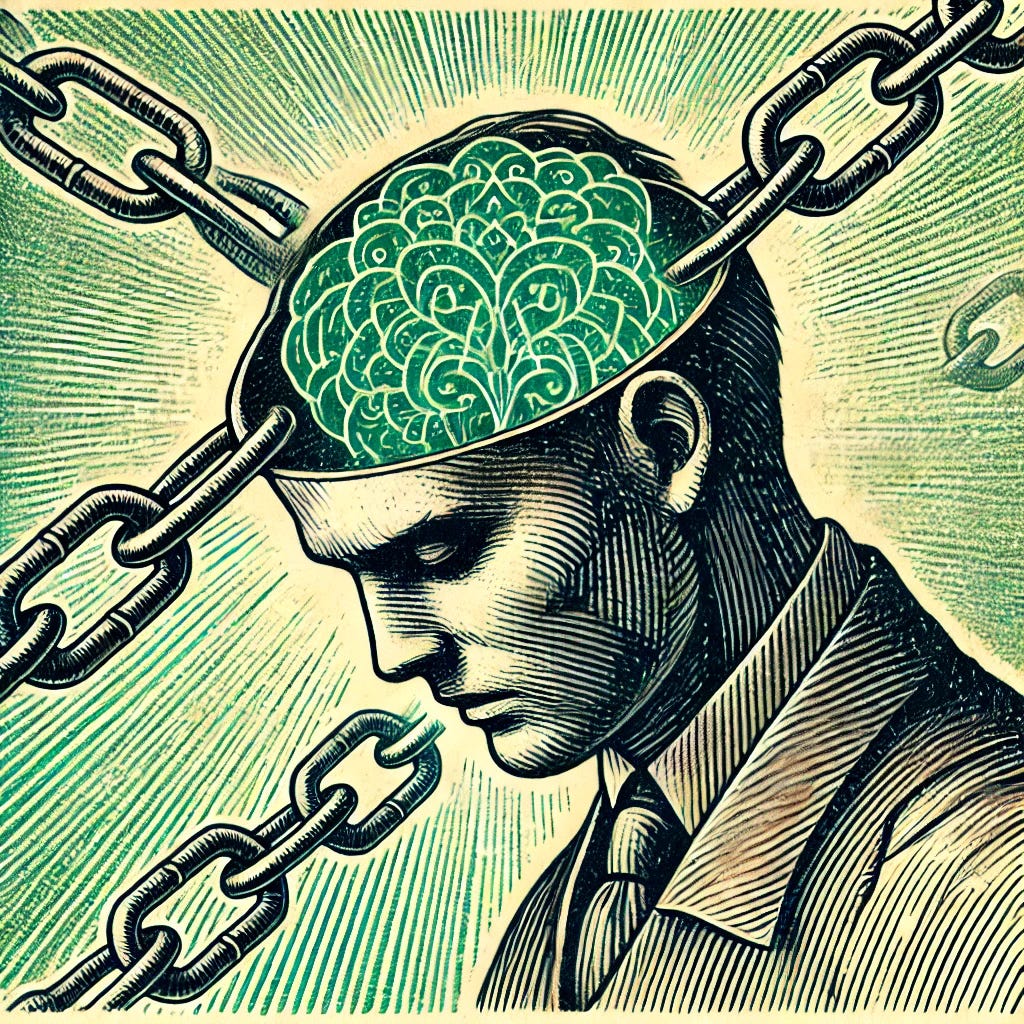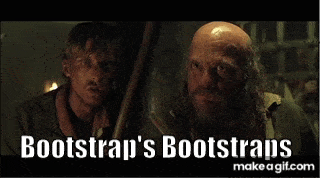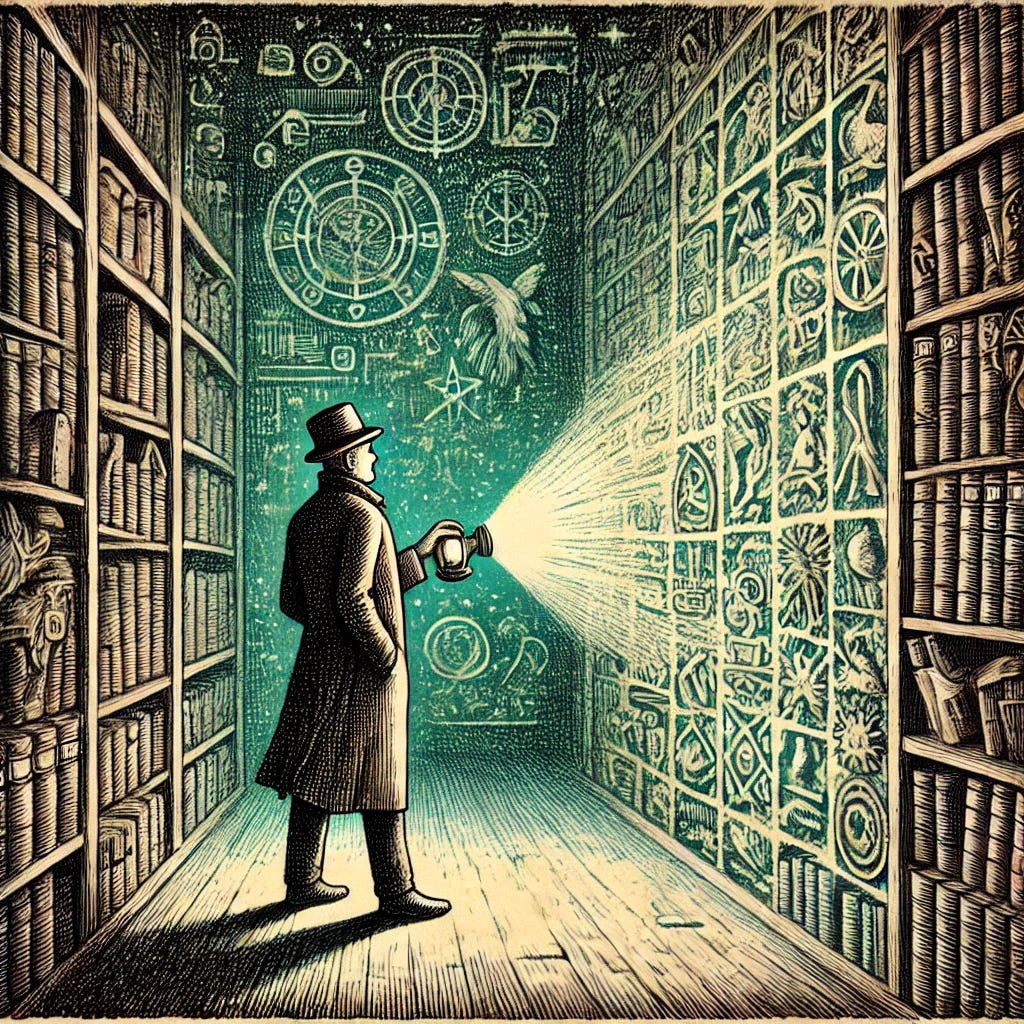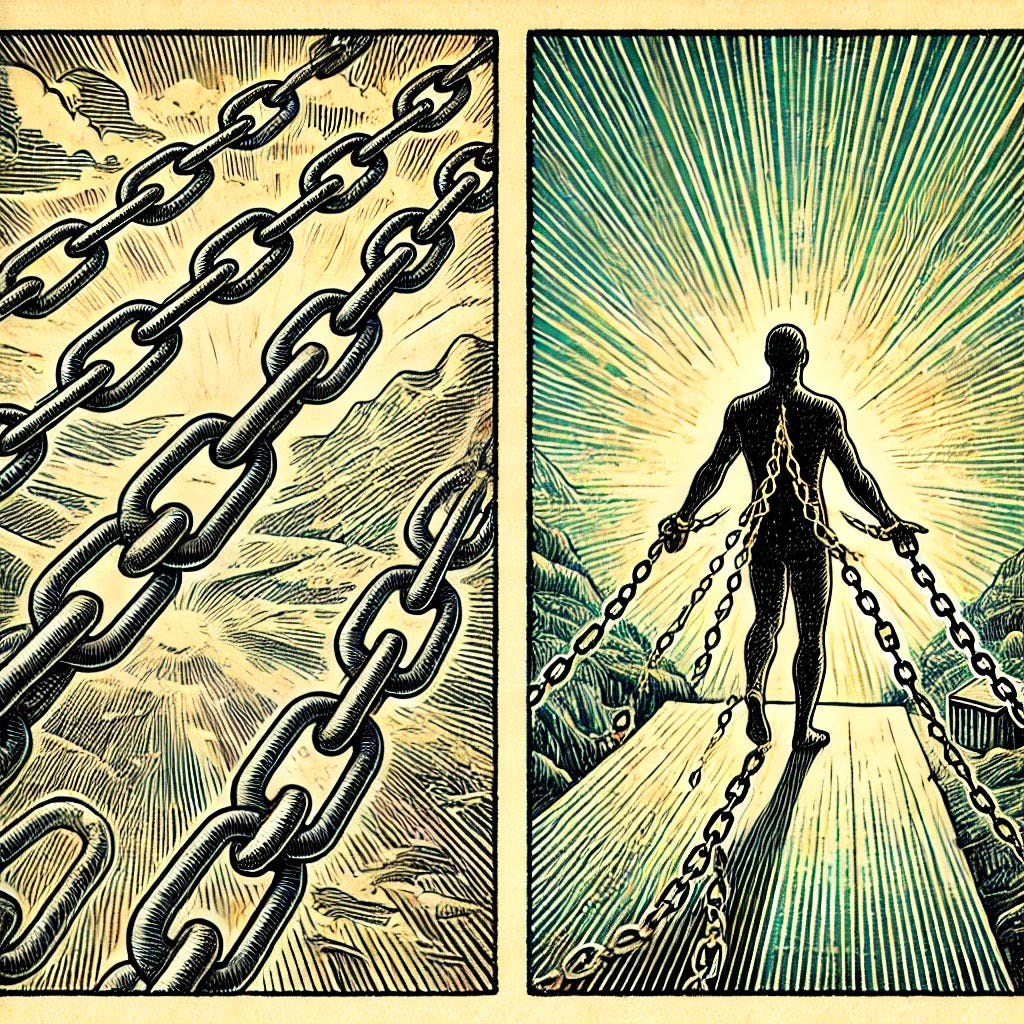The Hidden Code: Discovering the Beliefs That Run Your Life
How to find the invisible stories controlling your choices
The Rules We Never Question
Growing up in the Midwest, there were unspoken rules woven into the fabric of daily life. Don't knock on the neighbor's door before 9am on weekends. Don't invite yourself over to someone else's house. Don't be a bother. Don't impose.
These weren't harsh restrictions. They were presented as common courtesy: basic decency, the way good people behave in the world.
And I absorbed these lessons completely.
Fast-forward decades later to a sales conversation I’m having in downtown DC. I'm wrapping up what's been a great conversation with a potential client. They love the work we do, they're impressed with our approach, and they're ready to move forward.
This is the moment where any competent salesperson asks: "Who else do you know who might benefit from this kind of work?"
The words are right there. I know them. I’ve practiced them.
But I can't say them.
Instead, I thank them for their time, shake hands, and walk away, leaving money on the table and opportunities unexplored.
Why?
Because asking for a referral feels like imposing. It feels like being a bother. It feels like violating some deep code of conduct that was programmed into me decades ago in the suburbs of St. Louis.
This happened call after call, meeting after meeting. I'd built my entire career around helping others, but I couldn't bring myself to ask them to help me in return. Not because they wouldn't want to (most people love making valuable connections) but because a belief buried deep in my psyche whispered: Good people don't ask for things. Good people don't impose.
What I didn't realize was that this whisper wasn't truth. It was a limiting belief, and it had been quietly running my life for years.
The Invisible Operating System
We all carry beliefs like this: stories we tell ourselves about who we are, how the world works, and what's possible for us. Most of them operate completely below conscious awareness, like an invisible operating system running in the background of our minds.
"I'm not creative."
"I'm bad with money."
"I don't deserve success unless I work myself to exhaustion."
"People will judge me if I fail."
"I have to have it all figured out before I can start."
These beliefs feel like facts. They feel like reality.
But they're not.
These beliefs are constructions, carefully built by our brains over years of experience, reinforcement, and repetition. And for many of us, they've become the primary limitation, a chokepoint, on what we think we can achieve.
The challenge is that these beliefs are nearly impossible to see on our own. They're what psychologist Michael Shermer calls our "belief engine," the brain's evolved pattern-recognition system that connects dots and creates meaning from experience, often without our conscious involvement.
Here's the kicker: neuroscience research shows it's actually easier for our brains to believe something than to disbelieve it.
In a fascinating study, researchers put people in fMRI scanners and showed them various statements while monitoring their brain activity. What they found was remarkable: belief activated the brain's reward centers and happened faster than disbelief or uncertainty.
In short, believing is fast and feels good. Doubting takes work. And we almost always take the easy path.
This means our brains are naturally inclined to accept the patterns they detect as true, even when those patterns are incomplete or misleading. It’s easier for our minds to just accept a pattern, regardless of its accuracy or truth. And once a belief forms, we unconsciously seek out evidence that confirms it while ignoring evidence that contradicts it.
It's a perfect system for reinforcing whatever story we've already accepted about ourselves and the world.
But how do these invisible stories actually get written? Understanding the process reveals why they're so persistent and why they're so hard to change.
The Dopamine Loop of Self-Limitation
Here's how limiting beliefs actually form in your brain:
Early in life, you have an experience. Maybe you ask your dad for help with homework and he says "Figure it out. That's how you learn." Maybe you ask to join a group of kids playing and they tell you to go away. Maybe you never ask anyone for assistance, and you learn that self-reliance is a virtue.
Your brain, designed to keep you safe and help you navigate social situations, takes note: Asking for help leads to rejection/disappointment/judgment. Not asking for help leads to safety/approval/belonging.
Each time you encounter a similar situation and choose self-reliance over asking for help, your brain releases a small hit of dopamine (the "do that again" chemical). You've successfully avoided potential rejection. You've maintained your image as competent and independent. The neural pathway gets stronger.
Over time, this pattern becomes so automatic you're not even aware it's happening. The belief shifts from "asking for help didn't work that one time" to "I don't ask for help" to eventually "I can't ask for help. It's not who I am."
What started as a protective strategy becomes a core part of your identity.
That’s not all bad! Self-reliance is a good thing. People in the world could use more of it and good things can happen from a willingness to do good work and raise oneself up by the bootstraps.
However… the problem becomes when self reliance moves from ‘a truth’ to ‘the truth’. The very belief that once kept us safe often become the barrier that limits our growth. For me, the "I must do everything myself" belief that helped me avoid childhood disappointment was now preventing me from building meaningful business relationships and scaling my impact.
Mental Archaeology: Digging Up Your Hidden Beliefs
So how do you find beliefs you can't see? How do you excavate stories that have been running in the background for decades?
The process starts with becoming a detective in your own mind, looking for the patterns that reveal your hidden assumptions about reality.
Four Patterns That Reveal Your Hidden Beliefs
Pattern #1: The Emotional Red Flags
Your emotions are often the first clue that a limiting belief is operating. Strong emotional reactions (especially the disproportionate ones: extra anger, frustration or sadness) usually signal your psyche bumping against a threatened belief.
For me, the red flag was anxiety every time I considered asking for referrals. Not just nervousness, but deep visceral discomfort, like I was about to violate something sacred.
When you notice these reactions, get curious: What story am I telling myself? What am I afraid will happen if I do the thing I'm avoiding?
Pattern #2: The "I Always/Never" Statements
Listen to your internal dialogue and the stories you tell others about yourself. Limiting beliefs often show up as absolute statements:
"I'm just not a people person."
"I never finish what I start."
"I'm terrible at asking for what I need."
"I always put everyone else first."
These totalizing statements are rarely accurate. They're usually beliefs masquerading as facts.
When you catch yourself using this language, pause and ask: Is this actually always true? Can you think of any exceptions?
Pattern #3: The Areas Where You're Stuck
Look at the places in your life where you consistently struggle or avoid taking action despite having the knowledge and skills to succeed. These stuck points often reveal limiting beliefs.
Can't seem to raise your prices? There might be a belief about your worth.
Avoid networking events? Could be a belief about bothering people or not being interesting enough.
Struggle to delegate? Might be a belief that you have to do everything yourself to ensure it's done right.
The pattern is usually: I know what I should do, I know how to do it, but I consistently don't do it. That gap between knowledge and action is where beliefs live.
Pattern #4: The Family Echoes
Many of our deepest beliefs were inherited from our families and cultures. The stories our parents told about money, success, relationships, and what's possible in life often become our stories… until we consciously examine them.
My "don't be a bother" belief was pure Midwest culture, filtered through values about self-reliance and not imposing on others. It served family members well in their context, but it eventually came to limit me in mine.
Ask yourself: What did my family believe about success, money, relationships, asking for help? Which of these beliefs did I adopt without question?
If this pattern resonates, try this exercise:
Write down five things your family believed about money, success, or relationships.
For each one, ask: "Is this serving me now, or is it limiting me?" Often, beliefs that made perfect sense in your parents' context become obstacles in yours.
Next, for any belief that's limiting you, trace it back: When did you first learn this? What was the original context? What was your family trying to protect you from or help you achieve?
Finally, write a new belief that would serve you better. Don't just flip the old one to its opposite. Create something nuanced and true. For example, my old belief "Good people don't ask for things" became "Asking for help creates opportunities for others to contribute and connect."
The goal isn't to judge old beliefs as wrong. It's to consciously choose which stories you want to carry forward and which ones you're ready to update.
Once you start this excavation work, you'll likely experience what I call the awareness trap: the frustrating gap between knowing and changing.
Why Knowing Isn't Enough (The Awareness Trap)
Here's where it gets tricky: simply identifying a limiting belief isn't enough to change it.
I could clearly see that my reluctance to ask for referrals was holding me back. I understood intellectually that most people would be happy to make introductions. I even had evidence from the few times I did ask: it went fine, people were helpful, the world didn't end.
But the belief persisted.
This is because limiting beliefs aren't just thoughts. They're neural patterns reinforced thousands of times, connected to our identity, our sense of safety, and our understanding of how to belong.
Changing them requires more than insight. It requires rewiring.
The good news? Your brain is more malleable than you think. The same neuroplasticity that allowed these beliefs to form in the first place can be harnessed to transform them. But it takes the right approach. You need an approach that works with your brain's natural learning systems rather than against them.
The Science of Why Beliefs Resist Change
The research on changing limiting beliefs draws from several therapeutic approaches, but they all share common elements:
First, they create psychological safety. You can't rewire beliefs while your nervous system is in fight-or-flight mode. This means approaching the work with curiosity rather than judgment, and often working with a therapist, coach, or trusted friend who can provide external support.
Second, they challenge the evidence. Cognitive Behavioral Therapy has shown that beliefs often persist because we're selective about what evidence we pay attention to. Learning to question flimsy evidence and focus on concrete data can begin to loosen a belief's grip.
Third, they create new experiences. Narrative therapy recognizes that we can't just think our way out of limiting beliefs. We need to ‘live’ our way out of them. This means taking small, safe actions that contradict the old story and provide evidence for a new one.
Think of it like updating your brain's software. You can't just delete the old program. You have to install and run a new one until it becomes the default.
The Rewiring Process
For my "don't ask for help" belief, this meant starting with tiny requests in low-stakes situations. Asking a colleague for a book recommendation. Requesting an introduction to someone I was curious to meet. Each positive experience provided new data for my brain to process, slowly building evidence for a different story about what happens when I ask for things.
The process isn't always linear, and it requires patience with yourself as your brain learns new patterns. But it works, as long as you're willing to do the excavation work first.
Your Hidden Stories Are Waiting
The beliefs running your life right now aren't accidents. They were formed for good reasons, often by a younger version of yourself who was trying to navigate a complex world with limited information and resources.
That younger you did the best they could with what they had. But you're not that person anymore, and the strategies that once kept you safe might now be keeping you small.
The most liberating realization I've had in this work is that the story I was telling myself about not being able to ask for help wasn't protecting anyone. That story was actually limiting my ability to create value for others and build meaningful relationships.
When I finally started asking clients for referrals, something beautiful happened. Not only did my business grow, but my relationships deepened. People lit up when they could make valuable connections. They felt useful, appreciated, part of something bigger than themselves.
I had been so focused on not being a burden that I'd forgotten a fundamental truth: letting people help you is often a gift to them, not an imposition.
Your limiting beliefs are holding similar gifts hostage. What beliefs have been running your life from the shadows? Which stories that once kept you safe are now keeping you small? The most liberating realization isn't that you have limiting beliefs… everyone does. Freedom comes from realizing that you have the power to rewrite them.
The excavation starts now.
The discovery process is just the beginning. Once you've identified your limiting beliefs, the real work of changing them begins… but that's a story for another article. For now, start with awareness. Notice your emotional red flags, listen for your "always/never" statements, and get curious about the inherited echoes in your own story.







It’s a very beautiful and inspiring piece. We are shackled by ourselves yet we are rarely aware! Updating our internal models of the self and the world is the key.
I have definitely internalized that Mid-western ethos 🤔 I also have “always” thought I needed to do things myself if I wanted them done right. This was a very useful essay. Thanks for sharing your insights.